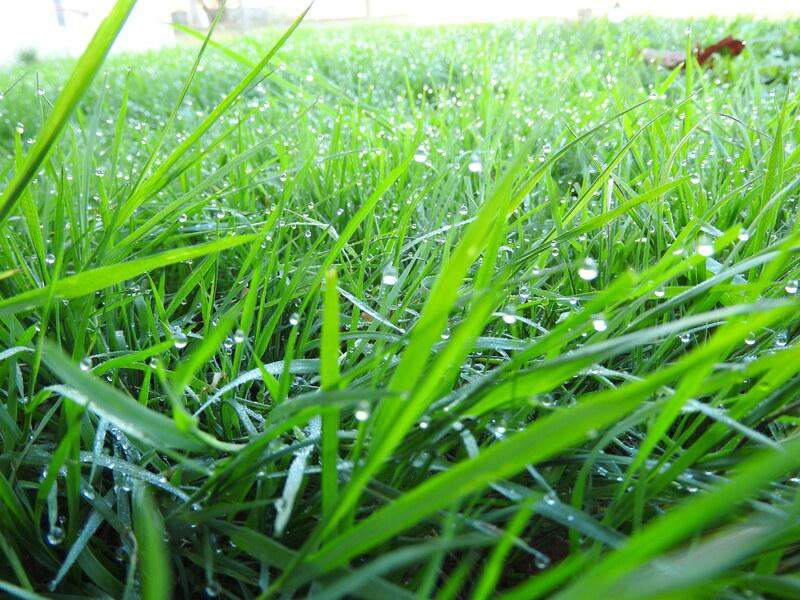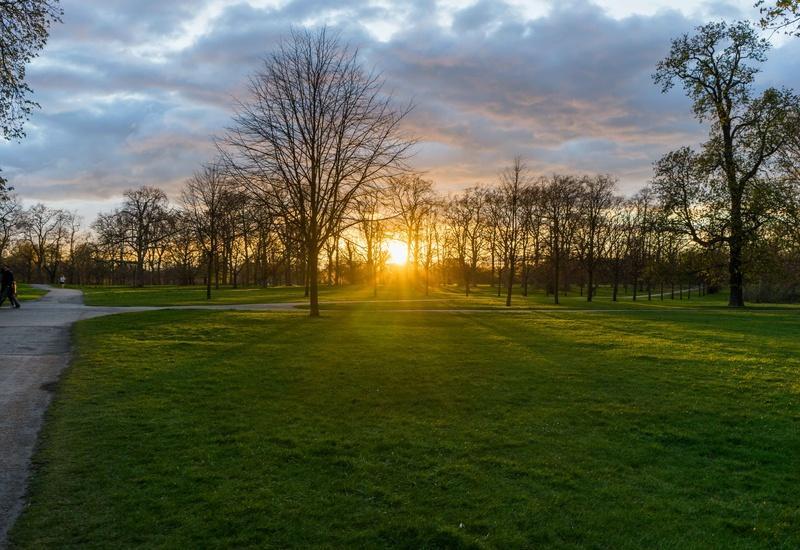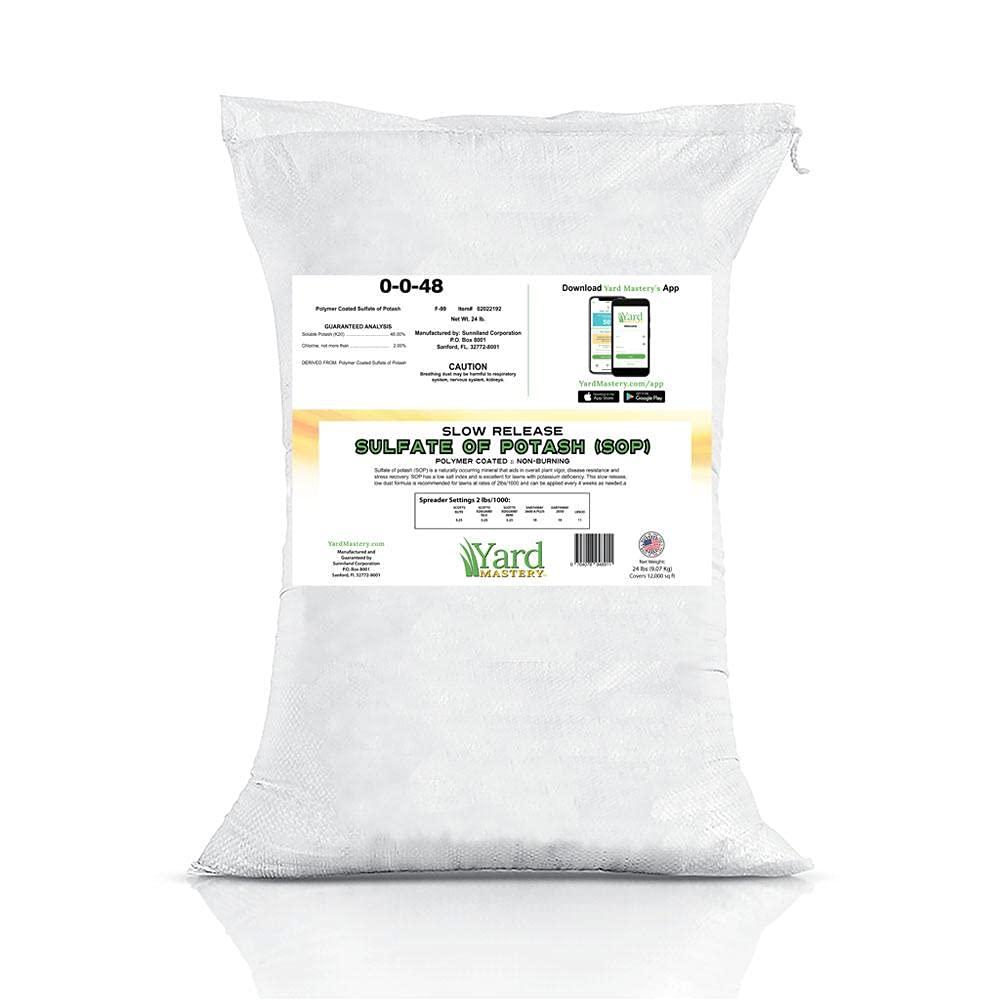Potassium is a nutrient that is essential for turf grass. The third number that is printed on fertilizer bags, such as 10-6-4, is potassium, which is also referred to as potash in some instances. The chemical symbol for potassium is “K,” and it is a macronutrient, just like nitrogen and phosphorus.
Macronutrients are required in greater quantities for healthy plant growth than micronutrients, which include iron, magnesium, and zinc. In this article, let’s discuss what is potash and what is it used for.

Potassium is an essential nutrient that promotes turfgrass root growth and lowers grass disease susceptibility.
Many lawn fertilizers put great emphasis on the first number, nitrogen because it assists in the growth of green and lush grass. However, potassium also plays an integral part in the development and overall health of the grass as well.
Understanding what potassium does for grass is beneficial for homeowners who want lush, green grass year after year.
However, you must remember that despite its importance, excessive potash can be detrimental to grass health as it affects how the soil absorbs and retains several other essential elements.
Therefore, if you feel your grass is suffering from a lack of potassium, you should get the soil of your tested. It is the most accurate technique for determining whether your plants could benefit from potash or not. Read on to learn more!
So, What Exactly Is Potash?

“Potash” refers to various mined and manufactured salts containing water-soluble potassium.
The agricultural sector relies on potash more than any other form of potassium to meet its fertilizer needs. The term “potash fertilizer” originally referred to a form of potassium fertilizer that was derived from wood ashes.
This technique is no longer used. However, the term “potash fertilizer” is still widely used to refer to a few different types of potassium-based fertilizers.
Potash is used in a variety of fertilizers, the most popular of which are muriate of potash (also known as potassium chloride) and sulfate of potash (potassium sulfate).
Although potash is naturally present in most soils, it does not always remain in a form that is easily accessible to plants. There are many different organic fertilizers though that are high in potassium.
Some examples are seaweed, kelp products, wood ash, and other materials that can be used as mulch or added to composts.
RELATED: How Often Should I Fertilize My Lawn? A Quick & Easy Guide To Lawn Fertilization
What Does Potash Do For The Grass?

Potassium gives the grass the strength to withstand stress, drought, and disease.
Potassium plays a very vital role in the overall growth and health of the grass. A potassium deficiency causes plants to have a lax structure, leaves with yellow margins, poor development, smaller than average leaf size, delayed growth, and necrosis in the leaves.
Here are a few key benefits of applying potash to your grass:
Assists Nutrient Uptake
Low potassium levels make it difficult for the grass to grow at its maximum because they prevent the root system from effectively absorbing the other nutrients. Potash improves the ability of the grass to absorb nutrients, thus increasing its storage capacity for vitamins and proteins.
This results in a plant that is both more healthy and more nutrient-dense.
Improves Water Uptake
When a proper amount of potassium is provided to your lawn, you may find that you need to water it a bit less. Potassium also improves the grass’s overall water-carrying capacity. This ensures that all parts of the grass receive the appropriate quantity of water. Grass that lacks potassium often turns yellow due to a lack of water.
Makes Cell Stroger
One of the most significant advantages of using potash is that it contributes to the development of grass with thicker cell walls. As a result, the grass grows strong and becomes somewhat immune to environmental factors such as cold, drought, and heat.
Makes Grass Disease Resistant
Potassium is an element that should definitely not be overlooked if you want your grass to be in better condition. Potassium helps to make your grass healthier by improving its resistance to fungal and bacterial attacks. This makes your plant more resistant to lawn diseases.
Promotes Grass Development
In plant tissue, potassium is involved in the flow of water, minerals, and carbohydrates. The opening and closure of the stomata, which controls the exchange of water vapor, oxygen, and carbon dioxide, are likewise regulated by potassium. So, a lack of potassium or inadequate potassium supply will impede plant growth and lower yield.
When To Add Potash To Lawn?
The best times to apply potassium to soil are typically in the fall and spring. However, some gardeners choose to give potassium in the winter so that the grass will have access to it when it is time for the grass to start growing again in the spring.
However, potash can be used at any time of the year because the advantages of replenishing a lawn deficient in potassium can be observed during any given season.
RELATED: How to Read Fertilizer Numbers? What Is The NPK Ratio? A Comprehensive Guide
How To Apply Potash For The Best Results?

Do not over-apply potash to your grass. It can harm your lawn very negatively.
The fertility of the lawn is an important component of proper lawn care. Therefore, it is very necessary to be aware of how to apply potash to lawns and how it affects a yard.
The soil type, the results of soil tests, and other criteria, such as personal choice or regulations, should all be taken into consideration before applying potash to your lawn. Nevertheless, here is how to correctly use potash on your grass:
Test Your Lawn Soil
Get a soil test from your local cooperative extension office before fertilizing your lawn with a potash-based product. Use a hand trowel when gathering soil samples from different areas of your yard.
Gather ten to fifteen-yard samples from a depth of three inches and mix them. There is no need to apply potash if the soil already contains a high potassium content. However, apply it to your lawn if the potassium level is low.
Calculate How Much Potash Do You Need!
The amount of potash that should be spread on your grass is another thing you need to figure out. You can find the specific application ratios listed on the fertilizer packaging. DO NOT go beyond the specified amount since excessive potassium levels in the lawn soil are detrimental to the grass and the soil’s long-term health.
Choose A Fertilizer With High Potassium Ratio
Choose a fertilizer that has a high potassium content to nitrogen ratio. If your grass has less than 25 parts per million potassium, apply muriate of potash or similar potassium-rich lawn fertilizer.
In the event that you use a potash compound that does not decompose easily, apply it as topdressing before mixing it in the top layer of the soil. Examples of these fertilizers include potassium chlorate or potassium sulfate.
Spread The Fertilizer Evenly
The simplest way to apply potash is with a fertilizer broadcaster, a piece of wheelbarrow-like equipment that spreads the fertilizer over the ground. Put it simply, spread the required fertilizer across your lawn in a uniform manner.
How Much Potash Should I Use?

Click here to learn about online tools that you can use to measure the area of your lawn accurately.
You should spread the potash across your grass based on the results of the soil test. When determining how much potash should be applied to a specific area, it is best to use the suggestions provided by the test results. Simply multiplying the length of your garden by its width will give you the area of your garden.
Lawns with potassium levels ranging from 25 to 50 ppm require 4 pounds of fertilizer per 1,000 sq. ft., while lawns with potassium levels ranging from 50 to 75 ppm require just 2 pounds of fertilizer over the same area.
If the potassium level in your lawn is between 75 and 100 ppm, you should apply one pound of fertilizer per 1,000 sq. ft.
Pro Tip: Only fertilize your lawn with dry fertilizer when the lawn is completely dry. Make sure there won’t be any precipitation for at least one day after fertilizing by checking the forecast before you start.
RELATED: The Best Time Of Day To Fertilize Your Lawn | A Comprehensive Guide
Types Of Potassium Fertilizers
Potash fertilizers can be found in two distinct physical forms, which are:
Liquid Soluble Potash

High Potassium Lawn Food Liquid Fertilizer 0-0-25 – Concentrated Spray
For homeowners with a small lawn who can’t afford the additional expense of a spreader, liquid fertilizers are a fantastic alternative. Liquid fertilizers can be easily applied to grass by connecting to the garden hose and doing so at the same time as watering the grass.
However, since you do not want to waste the product, it is essential to ensure that you read the directions on the packaging and do not apply excessive potassium.
Granular Potash

Yard Mastery 0-0-48 Granular Fertilizer Sulfate of Potash
The best way to thoroughly saturate your lawn with a potassium-rich fertilizer and bring your potassium levels up to the appropriate level is to use a granular potash fertilizer and spread it with a spreader.
This will give you the most coverage possible. If you want your fertilizer to be absorbed into the soil and get to the root zone of the grass, make sure to time the application of your fertilizer before a rain event.
Final Thoughts
Everyone is keen to see his front door alongside a thick and lush lawn. For this, you will not require the services of a landscape artist if you know what to do. It doesn’t matter if you start from seed or sod; what matters most is that you have a good plan and fertile soil.
If you are just starting to get serious about cultivating a healthy lawn, I would advise having the soil tested. Not only will this tell you the current level of readily available potassium in the soil, but it will also tell you the levels of other essential nutrients.
Next, apply the right amount to your lawn by reviewing the soil test results.
Frequently Asked Questions
Can You Put Too Much Potassium On Your Lawn?
The health of your lawn is not directly harmed by too much potassium, but it will affect how your soil absorbs other nutrients. It is why lawns with excessive potassium also show the symptoms of nitrogen and phosphorus deficiencies.
How Do You Increase Potassium In Soil?
You have many options if you want to increase potassium in your soil without using potash or another commercial potassium fertilizer. A great source of potassium is compost, mainly derived from food waste. Banana peels, in particular, contain a lot of potassium.
Will Potash Burn The Lawn?
Although small excess potassium won’t hurt the grass, if it’s combined with nitrogen and there’s too much of it on the lawn, the grass might burn. So, you shouldn’t put an excessive amount down on purpose because doing so would be wasteful and harmful to your grass.
Does Potash Need To Be Watered In?
If you’re using granular potash, make sure to water it thoroughly. Granular potash will not do anything other than sitting on the soil until it rains or you water it yourself. On the other hand, the liquid potash does not need to be watered.
What Are The Symptoms Of Potassium Deficiency In Plants?
Potassium-deficient plants can be identified by their tendency to wilt on hot, dry days. The plant appears to be withered or drooping overall. Short internodes, stocky looks, and stunted leaf growth are all signs of potassium deficient plants.
Sources For Further Reading
Turfgrass Fertilization: A Basic Guide for Professional Turfgrass Managers – The Pennsylvania State University Extension Service
Choosing Fertilizers for Home Lawns – University of Illinois Extension Service
Fertilizing | General Lawn Maintenance – Kansas State University Extension Service
Editor’s Recommendations
How To Get Rid of Moss in Your Lawn Naturally | Expert Tips & Tricks
Ryegrass Pros & Cons: Is Ryegrass Worth It? | A Guide To Growing Ryegrass
How Many Types Of Crabgrass Are There? A Comprehensive Guide







